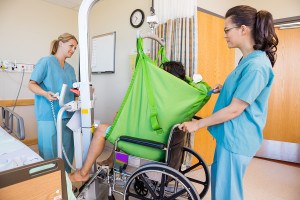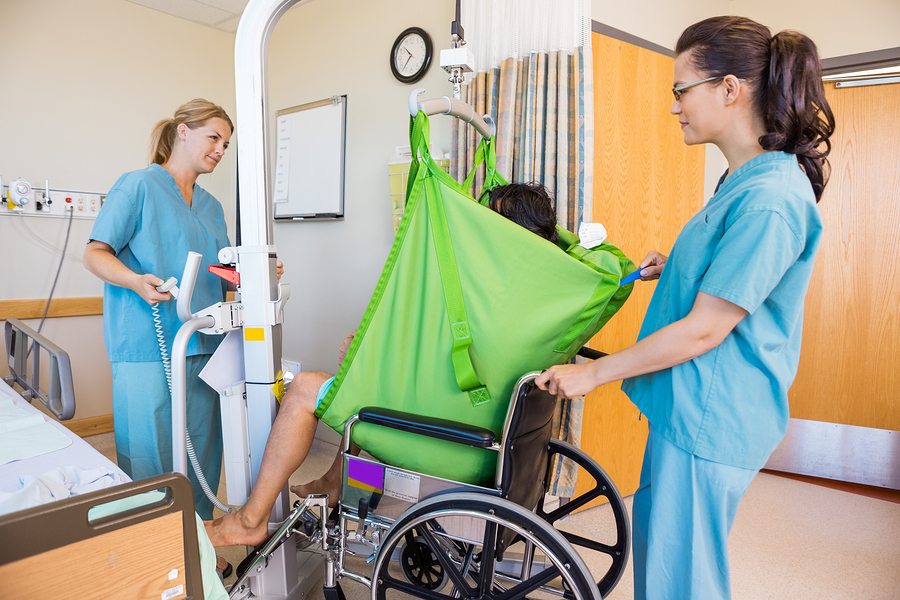National observances are a dime a dozen, fighting to claim a spot on the calendar as their own, with platforms as solid as National Sister’s Day and as iffy as Zucchini Bread Day.
Nurses, however, are an undeniable cut above the fray, earning the right to their own week beginning May 6 – and for good reason. Nurses are the ultimate “human doings,” coordinating patient care, juggling more patients and unsavory tasks than the average person can handle, often as the unsung hero behind a medical group, hospital or individual physician’s amply lauded success.
As industrious and necessary as they are, who will consider nurses as human beings?
An aggressive safety initiative in place at the Beckley Veteran’s Affairs Medical Center is considering patients but also the toll taking care of them can take on a nurse physically. For instance, nurses lift an average of 1.8 tons every shift.
“That equates to a hippo a day,” states Diana Smith, Restorative Nurse Coordinator and Safe Patient Handling Coordinator and a nurse since 1985, who is no stranger to her share of physical injury, a common collateral to her profession. “I worked home health and was caring for a lady who was bedfast. The daughter and I were turning her mother to do wound care. The daughter quit lifting her share and all of the weight shifted to me.”
Smith’s lower back bore the brunt of impact and suddenly went numb. She underwent physical therapy to be restored to normal functioning. Now, she is the point person working with two certified restorative nursing assistants trained in lift technology and changing the way nurses lift and move patients, also part of a national Veterans Health Administration safety initiative intended as much for nurses as it is for patients.
Matthew Gavin, a nursing assistant for 25 years, is one on the VAMC team who has become an expert in using motorized ceiling lifts and other devices to assist patient movement and to incorporate in bedside therapy.
His training of other nurses includes using the latest technology in shifting patients from the bed to chair, from chair to standing and back to the bed again, what sounds so simple but can quickly turn hazardous when the equivalent of even 110 pounds suddenly sandbags a nurse’s frame.
Another scenario to consider is the patient who becomes combative mid-transition, an especially distinct possibility for nurses working with an aging population.
The frequency of injuries and musculoskeletal disorders from the nursing profession have prompted the American Nurses Association to take the stance that no manual patient handling is safe patient handling. The ANA has developed national standards to help hospitals incorporate programs to ensure safer mobility of patients to protect nurses.
“With the ANA’s standards published in 2013, they will push to where there will be a national standard for safe patient handling programs, even outside of the VAMC,” Smith said, adding that she is proud the VA proactively embraced the cause nearly six years ago.
”
At one of the conferences I went to for training, the point was made that if you go to a grocery store, they don’t carry products in anymore – they have forklifts for that. Autobody shops don’t manually lift. Nursing was the last profession to use lifting devices. Now, with new technology, we are ahead of everybody in safety,” adds Gavin.
Nichole Hylton, also a restorative nursing assistant and a trainer to nurses on how to use lifts and slings for patient handling and mobility, discusses how easy it is for a patient to become an accidental threat to those assisting.
“For patients who have had a total hip or knee really replacement, they are scared as soon as they experience more pain with weight bearing. Sometimes a little is too much for them and any little thing can go wrong and the unexpected happens.”
Hylton’s warning is from experience. She had to switch to light duty for a week after a patient recovering from a knee replacement suddenly put his 180-pound weight on her much smaller frame. “He decided he couldn’t help me and we went down. I twisted the wrong way and couldn’t move after.”
Patient load having literally increased in number and individual size for the average patient in America, the risk for injury with manual handling has also gotten bigger, but nurses must be on guard even with smaller patients. Sudden dead weight is still dead weight.
“With the bigger patients, often nurses are more cautious and they expect it, but with smaller patients, nurses think ‘we can do this’ and that’s when a lot of accidents happen.”
As part of the VAMC’s safe patient handling and mobility directive, staff are encouraged not to lift over 35 pounds on the job without using the advanced lifting equipment provided by the hospital and virtually in every room – especially in the rehabilitation and long-term residential section of the facility.
Today’s lift technology is more sophisticated than the standard portable lifts common at most hospitals, and the decision to invest in the most advanced systems and to enforce their usage is intended to dramatically cut down on nurse injuries related to patient handling.
“This is not a suggestion, it’s an expectation, just like using gloves and washing your hands,” states Smith.
Nurses suffer more musculoskeletal injuries than any other profession, Smith comments, crediting her team with an informal observation that injuries are down at the Beckley VAMC, making for healthier patients and nurses happier to be protected from professional hazards.
“That’s why the VA started this in 2008; they wanted to establish a safe environment.”
From a practical standpoint, Hylton and Gavin both attest to feeling less like they’ve gone a few heavyweight rounds and more like it was a decent day at the office. Gavin noticed his back hurts less.
“It makes a big difference for nurses and nursing staff because you save your back and you save your arms and legs when it comes to transferring versus doing everything manually,”
Hylton elaborates. “It may take longer to get the right sling under a patient and to make sure the equipment is set up just right, but the perks of being able to safely move the patient and keep yourself from getting an injury makes it worthwhile.”
In addition to patient safety, Smith demonstrates her team’s resourcefulness at using the lift technology for patient rehabilitation.
“We had a resident recently with a stroke. Nichole would put a walking sling on him to build core strength up by attaching it to the ceiling lift,” said Smith.
“At first, our goal was for him to support himself for 10 seconds. Every day, we added a little more time, going from 10 seconds to 2 minutes in a week. We eventually got him to support himself for 7 minutes. He was able to hold himself up and give us a high five at different levels while maintaining his balance,” described Hylton. “We were able to accomplish this just by using the safe patient handling equipment.”
As a testimony to the VAMC’s training and usage of the equipment, The Joint Commission for Health Care found no citations or recommendations for improvement for the Community Living Center at a recent accreditation visit, where most of the equipment is employed routinely, reports Debbie Voloski, Public Affairs Officer for the Beckley VA Medical Center.
Only one factor in a comprehensive list of responsibilities, lift protocol can make a difference in the physical ramifications of the nursing profession, but it can’t alone appreciate.
This week, hug a nurse – but ask permission first, and don’t forget to bear your share of the weight.
Was this article valuable?
Here are more articles you may enjoy.


 US Eyeing Ship’s Electrical System After Baltimore Bridge Crash
US Eyeing Ship’s Electrical System After Baltimore Bridge Crash  Report: Vehicle Complexity, Labor ‘Reshaping’ Auto Insurance and Collision Repair
Report: Vehicle Complexity, Labor ‘Reshaping’ Auto Insurance and Collision Repair  CoreLogic Report Probes Evolving Severe Convective Storm Risk Landscape
CoreLogic Report Probes Evolving Severe Convective Storm Risk Landscape  Hawaiian Electric Hits 40-Year Low Ahead of Maui Fire Report
Hawaiian Electric Hits 40-Year Low Ahead of Maui Fire Report 